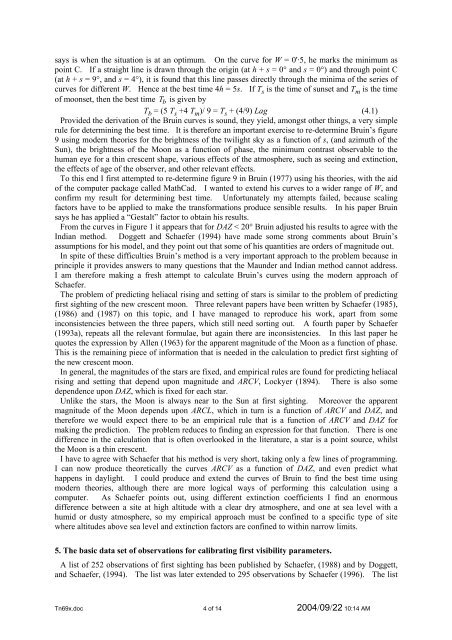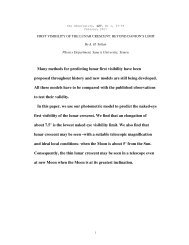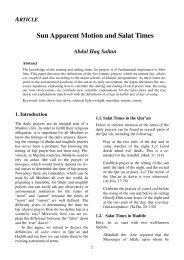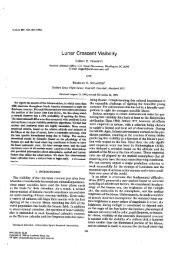A Method for Predicting the First Sighting of the New Crescent Moon ...
A Method for Predicting the First Sighting of the New Crescent Moon ...
A Method for Predicting the First Sighting of the New Crescent Moon ...
You also want an ePaper? Increase the reach of your titles
YUMPU automatically turns print PDFs into web optimized ePapers that Google loves.
says is when <strong>the</strong> situation is at an optimum. On <strong>the</strong> curve <strong>for</strong> W = 0'·5, he marks <strong>the</strong> minimum as<br />
point C. If a straight line is drawn through <strong>the</strong> origin (at h + s = 0° and s = 0°) and through point C<br />
(at h + s = 9°, and s = 4°), it is found that this line passes directly through <strong>the</strong> minima <strong>of</strong> <strong>the</strong> series <strong>of</strong><br />
curves <strong>for</strong> different W. Hence at <strong>the</strong> best time 4h = 5s. If T s is <strong>the</strong> time <strong>of</strong> sunset and T m is <strong>the</strong> time<br />
<strong>of</strong> moonset, <strong>the</strong>n <strong>the</strong> best time T b is given by<br />
T b = (5 T s +4 T m )/ 9 = T s + (4/9) Lag (4.1)<br />
Provided <strong>the</strong> derivation <strong>of</strong> <strong>the</strong> Bruin curves is sound, <strong>the</strong>y yield, amongst o<strong>the</strong>r things, a very simple<br />
rule <strong>for</strong> determining <strong>the</strong> best time. It is <strong>the</strong>re<strong>for</strong>e an important exercise to re-determine Bruin’s figure<br />
9 using modern <strong>the</strong>ories <strong>for</strong> <strong>the</strong> brightness <strong>of</strong> <strong>the</strong> twilight sky as a function <strong>of</strong> s, (and azimuth <strong>of</strong> <strong>the</strong><br />
Sun), <strong>the</strong> brightness <strong>of</strong> <strong>the</strong> <strong>Moon</strong> as a function <strong>of</strong> phase, <strong>the</strong> minimum contrast observable to <strong>the</strong><br />
human eye <strong>for</strong> a thin crescent shape, various effects <strong>of</strong> <strong>the</strong> atmosphere, such as seeing and extinction,<br />
<strong>the</strong> effects <strong>of</strong> age <strong>of</strong> <strong>the</strong> observer, and o<strong>the</strong>r relevant effects.<br />
To this end I first attempted to re-determine figure 9 in Bruin (1977) using his <strong>the</strong>ories, with <strong>the</strong> aid<br />
<strong>of</strong> <strong>the</strong> computer package called MathCad. I wanted to extend his curves to a wider range <strong>of</strong> W, and<br />
confirm my result <strong>for</strong> determining best time. Un<strong>for</strong>tunately my attempts failed, because scaling<br />
factors have to be applied to make <strong>the</strong> trans<strong>for</strong>mations produce sensible results. In his paper Bruin<br />
says he has applied a “Gestalt” factor to obtain his results.<br />
From <strong>the</strong> curves in Figure 1 it appears that <strong>for</strong> DAZ < 20° Bruin adjusted his results to agree with <strong>the</strong><br />
Indian method. Doggett and Schaefer (1994) have made some strong comments about Bruin’s<br />
assumptions <strong>for</strong> his model, and <strong>the</strong>y point out that some <strong>of</strong> his quantities are orders <strong>of</strong> magnitude out.<br />
In spite <strong>of</strong> <strong>the</strong>se difficulties Bruin’s method is a very important approach to <strong>the</strong> problem because in<br />
principle it provides answers to many questions that <strong>the</strong> Maunder and Indian method cannot address.<br />
I am <strong>the</strong>re<strong>for</strong>e making a fresh attempt to calculate Bruin’s curves using <strong>the</strong> modern approach <strong>of</strong><br />
Schaefer.<br />
The problem <strong>of</strong> predicting heliacal rising and setting <strong>of</strong> stars is similar to <strong>the</strong> problem <strong>of</strong> predicting<br />
first sighting <strong>of</strong> <strong>the</strong> new crescent moon. Three relevant papers have been written by Schaefer (1985),<br />
(1986) and (1987) on this topic, and I have managed to reproduce his work, apart from some<br />
inconsistencies between <strong>the</strong> three papers, which still need sorting out. A fourth paper by Schaefer<br />
(1993a), repeats all <strong>the</strong> relevant <strong>for</strong>mulae, but again <strong>the</strong>re are inconsistencies. In this last paper he<br />
quotes <strong>the</strong> expression by Allen (1963) <strong>for</strong> <strong>the</strong> apparent magnitude <strong>of</strong> <strong>the</strong> <strong>Moon</strong> as a function <strong>of</strong> phase.<br />
This is <strong>the</strong> remaining piece <strong>of</strong> in<strong>for</strong>mation that is needed in <strong>the</strong> calculation to predict first sighting <strong>of</strong><br />
<strong>the</strong> new crescent moon.<br />
In general, <strong>the</strong> magnitudes <strong>of</strong> <strong>the</strong> stars are fixed, and empirical rules are found <strong>for</strong> predicting heliacal<br />
rising and setting that depend upon magnitude and ARCV, Lockyer (1894). There is also some<br />
dependence upon DAZ, which is fixed <strong>for</strong> each star.<br />
Unlike <strong>the</strong> stars, <strong>the</strong> <strong>Moon</strong> is always near to <strong>the</strong> Sun at first sighting. Moreover <strong>the</strong> apparent<br />
magnitude <strong>of</strong> <strong>the</strong> <strong>Moon</strong> depends upon ARCL, which in turn is a function <strong>of</strong> ARCV and DAZ, and<br />
<strong>the</strong>re<strong>for</strong>e we would expect <strong>the</strong>re to be an empirical rule that is a function <strong>of</strong> ARCV and DAZ <strong>for</strong><br />
making <strong>the</strong> prediction. The problem reduces to finding an expression <strong>for</strong> that function. There is one<br />
difference in <strong>the</strong> calculation that is <strong>of</strong>ten overlooked in <strong>the</strong> literature, a star is a point source, whilst<br />
<strong>the</strong> <strong>Moon</strong> is a thin crescent.<br />
I have to agree with Schaefer that his method is very short, taking only a few lines <strong>of</strong> programming.<br />
I can now produce <strong>the</strong>oretically <strong>the</strong> curves ARCV as a function <strong>of</strong> DAZ, and even predict what<br />
happens in daylight. I could produce and extend <strong>the</strong> curves <strong>of</strong> Bruin to find <strong>the</strong> best time using<br />
modern <strong>the</strong>ories, although <strong>the</strong>re are more logical ways <strong>of</strong> per<strong>for</strong>ming this calculation using a<br />
computer. As Schaefer points out, using different extinction coefficients I find an enormous<br />
difference between a site at high altitude with a clear dry atmosphere, and one at sea level with a<br />
humid or dusty atmosphere, so my empirical approach must be confined to a specific type <strong>of</strong> site<br />
where altitudes above sea level and extinction factors are confined to within narrow limits.<br />
5. The basic data set <strong>of</strong> observations <strong>for</strong> calibrating first visibility parameters.<br />
A list <strong>of</strong> 252 observations <strong>of</strong> first sighting has been published by Schaefer, (1988) and by Doggett,<br />
and Schaefer, (1994). The list was later extended to 295 observations by Schaefer (1996). The list<br />
Tn69x.doc 4 <strong>of</strong> 14 2004 /09/ 22 10:14 AM








